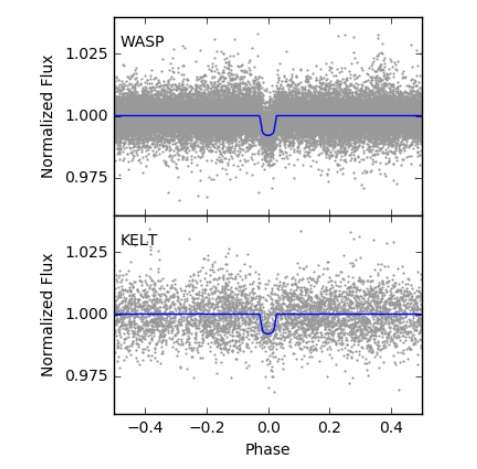The WASP (top) and KELT (bottom) discovery light curves for WASP 167b/KELT-13b, folded on the orbital period. The blue lines show the final model obtained in the MCMC fitting. Credit: Temple et al., 2017.
(Phys.org)—A "hot Jupiter" exoplanet transiting a rapidly rotating star has been discovered jointly by WASP and KELT survey, a new study reveals. The newly found alien world, designated WASP-167b/KELT-13b, is several times more massive than Jupiter and orbits its parent star every two days. The finding was presented Apr. 25 in a paper published on the arXiv pre-print repository.
The new giant planet was detected by a team of astronomers led by Lorna Temple of Keele University in Newcastle, U.K. The discovery is the result of two exoplanet surveys, namely the Wide Angle Search for Planets (WASP) and the Kilodegree Extremely Little Telescope (KELT). WASP observations, using the WASP-South telescope of the South African Astronomical Observatory (SAAO) in South Africa were carried out between May 2006 and June 2012. The KELT observing campaign, utilizing SAAO's KELT-South telescope, started in March 2010 and lasted till August 2013.
WASP-167/KELT-13 is a 1.3 billion-year-old F1V star with a rotation period estimated to be shorter than 1.8 days. With a radius of about 1.79 solar radii, this star is approximately 60 percent more massive than our sun. WASP-167/KELT-13 was observed by WASP and KELT teams independently from each other, and resulted in the detection of a planet-like transit signal.
Later follow-up observations of this star conducted in March 2016 using the European Southern Observatory's (ESO) 3.6-m/HARPS spectrograph provided the teams Doppler tomographic data. The new set of data revealed the planetary shadow, thus confirming the presence of an exoworld orbiting the star.
"In this work, we present the joint WASP/KELT discovery of a transiting hot Jupiter dubbed WASP-167b/KELT-13b. The 1.5 Rjup planet was confirmed by Doppler tomography of the stellar line profiles during transit," the researchers wrote.
According to the paper, WASP-167b/KELT-13b has a radius of about 1.51 Jupiter radii and its maximum mass is estimated to be eight Jupiter masses. The planet is in a retrograde orbit with a sky-projected spin-orbit angle of –165 degrees. Given the fact that the newly found exoworld also has a short orbital period, it was classified as a so-called "hot Jupiter". Exoplanets of this type are similar in characteristics to Jupiter, with orbital periods of less than 10 days. They have high surface temperatures, as they orbit their parent stars very closely.
In addition to revealing basic parameters of the newly detected planet, the researchers also provided some new insights into the nature of the host star. The study finds that WASP-167/KELT-13 has an effective temperature of 6,900 K and experiences non-radial stellar pulsations. These pulsations appear to have a timescale of about four hours, which is longer compared to similar stars with detected pulsations (like WASP-33 and HAT-P-2) that are near the borderline between Delta Scuti and Gamma Doradus variables. Therefore, the scientists are unable to definitely classify WASP-167/KELT-13 at the moment.
The researchers emphasized the significance of their discovery, concluding that the WASP-167/KELT-13 system is one of the few detected so far with a stellar rotation period less than the planetary orbital period. Moreover, WASP-167/KELT-13 is one of the hottest and most rapidly rotating stars known to host a "hot Jupiter" exoplanet.
More information: WASP-167b/KELT-13b: Joint discovery of a hot Jupiter transiting a rapidly-rotating F1V star, arXiv:1704.07771 [astro-ph.EP] arxiv.org/abs/1704.07771
Abstract
We report the joint WASP/KELT discovery of WASP-167b/KELT-13b, a transiting hot Jupiter with a 2.02-d orbit around a V = 10.5, F1V star with [Fe/H] = 0.1 ± 0.1. The 1.5 RJup planet was confirmed by Doppler tomography of the stellar line profiles during transit. We place a limit of < 8 MJup on its mass. The planet is in a retrograde orbit with a sky-projected spin-orbit angle of λ=−165∘±5∘. This is in agreement with the known tendency for orbits around hotter stars to be more likely to be misaligned. WASP-167/KELT-13 is one of the few systems where the stellar rotation period is less than the planetary orbital period. We find evidence of non-radial stellar pulsations in the host star, making it a δ-Scuti or γ-Dor variable. The similarity to WASP-33, a previously known hot-Jupiter host with pulsations, adds to the suggestion that close-in planets might be able to excite stellar pulsations.
© 2017 Phys.org
























